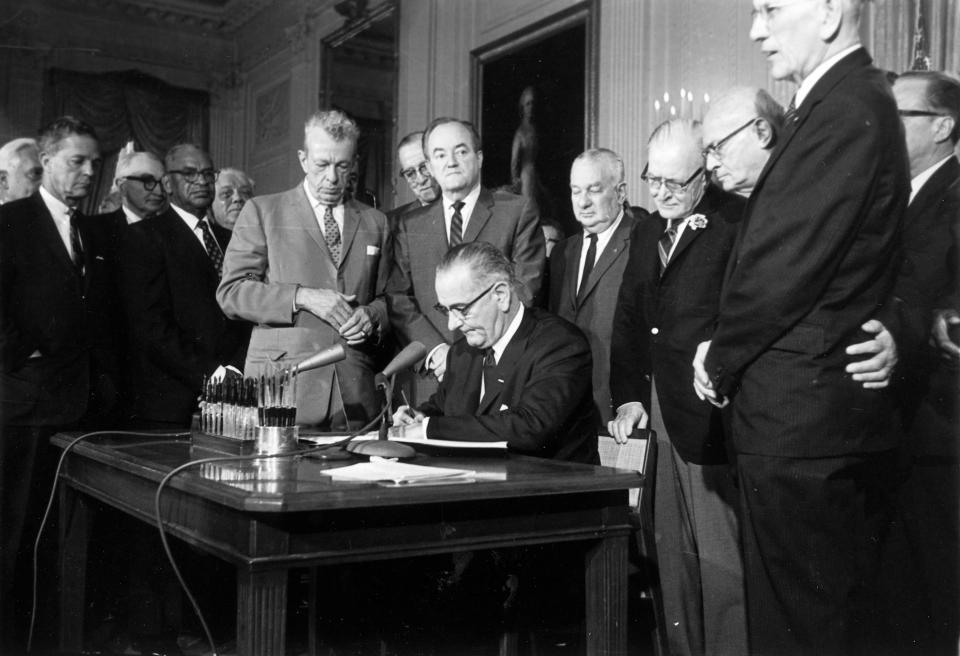How Bacon’s Rebellion of the 17th century accelerated legalized racism in America | Column
- Oops!Something went wrong.Please try again later.
- Oops!Something went wrong.Please try again later.
Plantation owners gazed in fear at the smoldering ruins of Jamestown. Nathaniel Bacon and his unusual band of rebels were on the run. Something had to be done to address the threat to the plantations, so Virginia’s landed gentry planted another crop.
Amidst the blood, fire, and tobacco, the roots of racism sunk deep into American soil.
In 17th Century Virginia, colonists paid the heavy burden of British taxes with tobacco because currency was scarce. Wealthy plantation owners dispensed with the assessments out of their largess, but smaller planters struggled to make ends meet.
Free and enslaved Blacks found themselves similarly situated with former and current indentured servants of European descent. The upper class owned the land; the rest worked it.
Hear more Tennessee Voices: Get the weekly opinion newsletter for insightful and thought provoking columns.
A dispute among white men and Native Americans led to bloodshed
Bacon was one of the elite. A cousin of Colonial Gov. William Berkeley by marriage, Bacon arrived in Virginia to a land grant and a seat on the Governor’s Council. He also turned out to be politically cunning.
He understood the power of grievance and hoped to use it to advance his fortunes. He recognized that many colonists viewed the Native Americans along their border as an ongoing threat. Without the wealth of plantation owners, poorer colonists also viewed seizing Indian lands as a tool for social and economic mobility. Governor Berkeley, by contrast, viewed accommodation of friendly tribes as essential to colonial prosperity.
The tinderbox was set, and a conflict along the Potomac River in July of 1675 lit the fuse.
According to the Virginia Museum of History and Culture, a disagreement between merchant-planter Thomas Mathew and the Doeg Indians resulted in Mathew killing several Doeg who attempted to steal livestock from his farm.
In retaliation, the Virginia militia intended to raid the Doeg but mistakenly attacked the friendly Susquehannocks. The militia’s attack caused Indian raids to break out across the frontier. Virginia’s governing class couldn’t reach an agreement over how to address the increasing violence.
Bacon saw opportunity.
Sign up for Black Tennessee Voices newsletter: Read compelling columns by Black writers from across Tennessee.

Your state. Your stories. Support more reporting like this.
A subscription gives you unlimited access to stories across Tennessee that make a difference in your life and the lives of those around you. Click here to become a subscriber.
Bacon used racial animus to justify his massacre
Mathew’s firsthand account of the rebellion later copied by Thomas Jefferson provides intimate details of the evolving political row. Bacon positioned himself as a champion of the people against the Indian threat.
Taking command of a volunteer militia, Bacon sought a commission from Governor Berkeley to fight the Indians. Berkeley, who hoped to prosper himself and his cronies by peaceful trade with the Indians, denied Bacon’s request.
Undeterred, Bacon and his militia raided, killed, and looted Indians in the area without the governor’s blessing. Berkeley declared Bacon a rebel and ousted him from his seat on the Council.
Bacon branded Berkeley as a corrupt Indian sympathizer in his “Declaration of the People.” The emerging power struggle pitted Bacon and his populist rebels against Berkeley and the rest of the colony’s powerful leaders. After months of fighting, Bacon’s forces captured Jamestown and burned it to the ground on September 19, 1676.
The following month, Bacon died abruptly of dysentery and his body was never found. Without Bacon, the rebellion came to an unceremonious end.
Sign up for Latino Tennessee Voices newsletter: Read compelling stories for and with the Latino community in Tennessee.
How race became an efficient fault line for colonial leaders
The short-lived rebellion unmistakably garnered the attention of Virginia’s governing elite who recognized the threat posed by an armed coalition of the middle and lower classes. Berkeley noted their shared sentiment, “How miserable that man is that Governs a People when six parts of Seaven at least are Poor Endebted Discontented and Armed.”

So Virginia's colonial government elected to divide and conquer. Race offered an efficient fault line.
In the decades following Bacon’s Rebellion, plantation owners actively fomented racial hatred between Blacks and whites to prevent their social and political alignment. In 1680, Virginia enacted legislation preventing enslaved persons from raising a hand to any “christian.” In 1691, the state banished Virginians in interracial marriages from the colony. In 1705, the Virginia Slave Act of 1705 confiscated property from enslaved Blacks and applied the proceeds “to the use of the [white] poor.”
Learn from the lessons of Bacon's Rebellion
The social engineering of institutional racism wasn’t even particularly well disguised. Lawmakers literally connected the economic advancement of poor whites with the oppression of enslaved Blacks.
While Bacon’s Rebellion certainly didn’t give birth to racism, it accelerated its adoption as a matter of law. By socially disconnecting Blacks from whites, the colonial ruling class ensured a cheap source of labor while denying middle and lower class whites the votes to mount serious political challenges.

Almost 300 years later, President Lyndon Johnson captured the mindset of the politically powerful colonists quite well. “If you can convince the lowest white man he’s better than the best [Black] man, he won’t notice you’re picking his pocket. Hell, give him somebody to look down on, and he’ll empty his pockets for you.”
As American society continues to consider race, we shouldn’t ignore Bacon’s Rebellion as a meaningful catalyst for the overt racism which imbued race itself with such unnatural and destructive meaning.
In a relatively short historical window, race migrated from an identifying criterion more akin to hair color to a horrific tool of social and economic control. The poisoned fruit of institutionalized racism we experience today isn’t a historical weed. America’s colonial elite planted it with great intentionality and care to protect their economic and political interests.
Our challenge is to ensure history doesn’t repeat itself.
USA TODAY Network Tennessee Columnist Cameron Smith is a Memphis-born, Brentwood-raised recovering political attorney raising three boys in Nolensville, Tennessee, with his particularly patient wife, Justine. Direct outrage or agreement to smith.david.cameron@gmail.com or @DCameronSmith on Twitter. Agree or disagree? Send a letter to the editor to letters@tennessean.com.
This article originally appeared on Nashville Tennessean: American history: How Bacon’s Rebellion accelerated legalized racism

